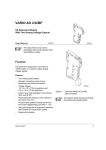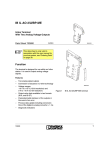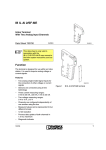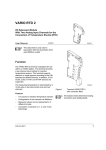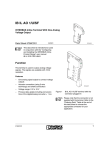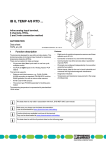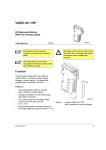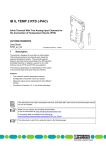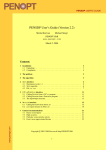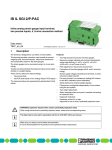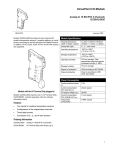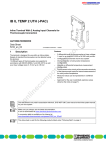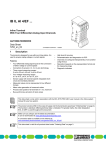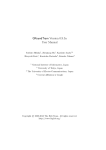Download IB IL AO 2/U/BP (-PAC)
Transcript
IB IL AO 2/U/BP (-PAC) D S O2 AO Inline Terminal With Two Analog Voltage Outputs AUTOMATIONWORX Data Sheet 5660_en_02 1 © PHOENIX CONTACT - 04/2007 Description The terminal is designed for use within an Inline station. It is used to output analog voltage signals. Features – – – – – – – – Two analog signal outputs Actuator connection in 2-wire technology with shield connection Voltage ranges: -10 V to +10 V (13-bit resolution) and 0 V to +10 V (12-bit resolution) Output value data available in two formats (IB IL and IB ST) Parameterizable behavior of the outputs in the event of an error Process data update including conversion time of the digital/analog converter < 1 ms Very good output driver properties, therefore also suitable for long actuator cables Diagnostic indicators This data sheet is only valid in association with the IL SYS INST UM E user manual or the Inline system manual for your bus system. Make sure you always use the latest documentation. It can be downloaded at www.download.phoenixcontact.com. A conversion table is available on the Internet at www.download.phoenixcontact.com/general/7000_en_00.pdf. This data sheet is valid for the products listed on the following page: IB IL AO 2/U/BP (-PAC) Table of Contents 1 Description.................................................................................................................................. 1 2 Ordering Data ............................................................................................................................. 3 3 Technical Data............................................................................................................................ 3 4 Local Diagnostic and Status Indicators and Terminal Point Assignment ................................... 7 4.1 4.2 4.3 4.4 Local Diagnostic and Status Indicators .......................................................................................................... 7 Function Identification .................................................................................................................................... 7 Terminal Point Assignment ............................................................................................................................ 7 Parameterized Default Upon Delivery............................................................................................................ 7 5 Installation Instructions ............................................................................................................... 7 6 Internal Circuit Diagram.............................................................................................................. 8 7 Electrical Isolation....................................................................................................................... 9 8 Connection Notes ....................................................................................................................... 9 9 Connection Example ............................................................................................................................................ 9 10 Connecting Shielded Cables Using the Shield Connector ........................................................10 11 Programming Data .............................................................................................................................................. 11 11.1 11.2 Local Bus (INTERBUS)................................................................................................................................ 11 Other Bus Systems ...................................................................................................................................... 11 12 Process Data .............................................................................................................................12 12.1 12.2 12.3 12.4 Assignment of the Terminal Points to the OUT Process Data Words.......................................................... 12 Assignment of the IN Process Data Words.................................................................................................. 13 OUT Process Data ....................................................................................................................................... 14 IN Process Data ........................................................................................................................................... 15 13 Formats for Representing the Output Values ............................................................................16 13.1 13.2 "IB IL" Format............................................................................................................................................... 16 "IB ST" Format ............................................................................................................................................. 18 14 Output Behavior.........................................................................................................................19 14.1 14.2 14.3 14.4 14.5 Output Behavior During Error-Free Operation (Normal Operation) ...................................................................................................................................... 19 Output Behavior in the Event of an Error ..................................................................................................... 19 Output Behavior of the Voltage Output ........................................................................................................ 19 Response of the Control System or Computer to a Hardware Signal for Different Control or Computer Systems .................................................................................................. 20 Response of the Voltage Output to a Control Command of the INTERBUS Controller Board .................... 20 15 Input Behavior ...........................................................................................................................21 16 Parameterization .......................................................................................................................22 5660_en_02 PHOENIX CONTACT 2 IB IL AO 2/U/BP (-PAC) 2 Ordering Data Products Description Type Order No. Pcs./Pkt. Inline terminal with two analog voltage outputs, complete with accessories (connector and labeling field) IB IL AO 2/U/BP-PAC 2861467 1 Inline terminal with two analog voltage outputs, without accessories IB IL AO 2/U/BP 2732732 1 Type Order No. Pcs./Pkt. IB IL SCN-6 SHIELD-TWIN 2740245 5 The connector listed below is needed for the complete fitting of the IB IL AO 2/U/BP terminal. Accessories Description Connector with six spring-cage connections and shield connection (green, w/o color print) Documentation Description Type Order No. Pcs./Pkt. "Automation Terminals of the Inline Product Range" user manual IL SYS INST UM E 2698737 1 "Configuring and Installing the INTERBUS Inline Product Range" user manual IB IL SYS PRO UM E 2743048 1 3 Technical Data General Data Housing dimensions (width x height x depth) 12.2 mm x 120 mm x 71.5 mm Weight 48 g (without connector), 70 g (with connector) Operating mode Process data mode with 2 words Connection method for actuators 2-wire technology Ambient temperature (operation) -25°C to +55°C Ambient temperature (storage/transport) -25°C to +85°C Permissible humidity (operation/storage/transport) 10% to 95% according to DIN EN 61131-2 Permissible air pressure (operation/storage/transport) 70 kPa to 106 kPa (up to 3000 m above sea level) Degree of protection IP20 according to IEC 60529 Class of protection Class 3 according to VDE 0106, IEC 60536 Connection data for Inline connector Connection method Spring-cage terminals Conductor cross-section 0.2 mm2 to 1.5 mm2 (solid or stranded), 24 - 16 AWG Interface Local bus Data routing Transmission Speed IB IL AO 2/U/BP, IB IL AO 2/U/BP-PAC 5660_en_02 500 kbps PHOENIX CONTACT 3 IB IL AO 2/U/BP (-PAC) Power Consumption Communications power UL 7.5 V Current consumption at UL 33 mA, typical; 40 mA, maximum (approximately) I/O supply voltage UANA 24 V DC Current consumption at UANA No-load operation (RL > 10 MΩ) 18 mA, typical; 28 mA, maximum Full load operation (RL = 2 kΩ) 25 mA, typical; 35 mA, maximum Total power consumption No-load operation (RL > 10 MΩ) 0.68 W, typical Full load operation (RL = 2 kΩ) 0.85 W, typical Supply of the Module Electronics and I/O Through the Bus Coupler/Power Terminal Connection method Potential routing Derating: Permissible Ambient Temperature Depending on the Current of the Potential Jumpers UM and US (Total Current) I [A ] 1 0 8 6 4 2 0 4 8 4 9 5 0 5 1 5 2 5 3 5 4 5 5 5 6 T A [° C ] 5 6 6 0 0 0 1 2 Above TA = +50°C derating is 2 A/K. TA Ambient temperature in °C I Current flowing through the potential jumpers UM and US in A 5660_en_02 PHOENIX CONTACT 4 IB IL AO 2/U/BP (-PAC) Analog Outputs Number 2 Signal connection method 2-wire technology, single-ended Signals/resolution in the process data word (quantization) Voltage -10 V to +10 V 333.33 µV/LSB Voltage 0 V to +10 V 333.33 µV/LSB Representation of output value -10 V to +10 V 16-bit two's complement 0 V to +10 V 16-bit two's complement For the representation of the output value in the different formats, please refer to the notes in "Formats for Representing the Output Values" on page 16. Smallest DAC quantization step -10 V to +10 V 2.667 mV (13 bits) 0 V to +10 V 2.667 mV (12 bits) Basic error limit ±0.02%, typical, of the output range final value Output load 2 kΩ, minimum Process data update time including conversion time of the digital/analog converter 1 INTERBUS cycle (depending on the bus configuration); <1 ms Signal rise time (slew rate) 10% to 90% of the final value 15 µs, typical 0% to > 99% of the final value 31 µs, typical Signal rise time (slew rate) (-9.0 V to + 9.0 V) No-load operation 0.35 V/µs, typical With ohmic load (RL = 2 kΩ) 0.24 V/µs, typical With ohmic/capacitive load RL = 2 kΩ / CL = 10 nF 0.24 V/µs, typical With ohmic/capacitive load RL = 2 kΩ / CL = 220 nF 0.09 V/µs, typical Transient protection of analog outputs Yes Maximum cable length for the LiYCY (TP) cable type, (shielded twisted power station cable) 500 m Electrical features of LiYCY (TP) Inductance Effective capacitance N x 2 x 0.5 (N= number of wire pairs, wire cross-section ≥ 0.5 mm2 0.67 mH/km, typical 120 nF/km, typical Tolerance Behavior and Temperature Response (Absolute Tolerance Values) (The tolerance values refer to the output range final value of 10 V.) Typical Maximum Total offset voltage ±0.5 mV ±4.0 mV Gain error ±2.5 mV ±6.0 mV Differential non-linearity ±1.3 mV ±3.9 mV ±4.3 mV ±13.9 mV Tolerance at 23°C Total tolerance at 23°C Temperature response at -25°C to +55°C Offset voltage drift TKVO ±2.1 mV ±5.0 mV Gain drift TKG ±9.2 mV ±20.0 mV Total voltage drift TKtot = TKVO + TKG Total tolerance of the voltage output (-25°C to +55°C) offset error + gain error + linearity error + drift error 5660_en_02 ±11.3 mV ±25.0 mV ±15.6 mV ±38.9 mV PHOENIX CONTACT 5 IB IL AO 2/U/BP (-PAC) Tolerance Behavior and Temperature Response (Relative Tolerance Values) (The tolerance values refer to the output range final value of 10 V.) Typical Maximum Total offset voltage ±0.005% ±0.027% Gain error ±0.025% ±0.060% Differential non-linearity ±0.013% ±0.027% ±0.09% ±0.14% Tolerance at 23°C Total tolerance at 23°C Temperature response at -25°C to +55°C Offset voltage drift TKVO 4 ppm/K 10 ppm/K Gain drift TKG 18 ppm/K 40 ppm/K Total voltage drift TKtot = TKVO + TKG 23 ppm/K 50 ppm/K ±0.16% ±0.39% Total tolerance of the voltage output (-25°C to +55°C) offset error + gain error + linearity error + drift error Additional Tolerances Influenced by Electromagnetic Fields Type of Electromagnetic Interference Typical Deviation From the Output Range Final Value (Voltage Output) Relative Absolute Electromagnetic fields; field strength 10 V/m according to EN 61000-4-3/IEC 61000-4-3 < ±0.2% < ±20 mV Conducted interference Class 3 (test voltage 10 V) according to EN 61000-4-6/IEC 61000-4-6 < ±2.8% < ±280 mV Safety Equipment Transient protection of analog outputs Yes Electrical Isolation/Isolation of the Voltage Areas The values are valid for shielded and unshielded twisted actuator cables. Common Potentials 24 V I/O voltage, 24 V segment voltage, and GND have the same potential. FE is a separate potential area. Separate Potentials in the System Consisting of Bus Coupler/Power Terminal and I/O Terminal - Test Distance - Test Voltage 7.5 V supply (bus logic), 24 V supply UANA / I/O 500 V AC, 50 Hz, 1 min 7.5 V supply (bus logic), 24 V supply UANA / functional earth ground 500 V AC, 50 Hz, 1 min 24 V supply (I/O) / functional earth ground 500 V AC, 50 Hz, 1 min Error Messages to the Higher-Level Control or Computer System Failure of or insufficient communications power UL Yes, I/O error message sent to the bus coupler Approvals Information on current approvals can be found on the Internet at www.download.phoenixcontact.com. 5660_en_02 PHOENIX CONTACT 6 IB IL AO 2/U/BP (-PAC) 4 Local Diagnostic and Status Indicators and Terminal Point Assignment D O -S A O 2 4.3 Terminal Point Assignment Terminal Point 1.1 2.1 1.2, 2.2 1.3, 2.3 1.4, 2.4 4.4 Signal Assignment U1 U2 – AGND Shield Voltage output 1 Voltage output 2 Not used Voltage output ground Shield connection Parameterized Default Upon Delivery By default upon delivery, the parameters are set as follows: Data format: Behavior of the outputs in the event of an error: Output range: IB IL Outputs hold the last value (Hold) -10 V to +10 V The following terminal parameters can be configured according to your conditions using the process data: 1 2 1 .1 1 1 2 .1 1 .2 2 2 2 .2 1 .3 3 3 2 .3 1 .4 4 4 2 .4 Data format: Behavior of the outputs in the event of an error: Output range: For parameterization you must switch to parameterization mode. The procedure is described in "Parameterization" on page 22. 5 6 6 0 B 0 0 2 Figure 1 4.1 Local Diagnostic and Status Indicators Desig. D O-S 4.2 Terminal with appropriate connector Color Meaning Green Diagnostics Orange Original default state parameterized IB ST Outputs are reset to 0 V (Reset) 0 V to +10 V 5 Installation Instructions High current flowing through potential jumpers UM and US leads to a temperature rise in the potential jumpers and inside the terminal. Observe the following instruction to keep the current flowing through the potential jumpers of the analog terminals as low as possible: Function Identification Yellow Create a separate main circuit for each analog terminal. If this is not possible in your application and if you are using analog terminals in a main circuit together with other terminals, place the analog terminals behind all the other terminals at the end of the main circuit. Please note the derating curve shown on page 4. 5660_en_02 PHOENIX CONTACT 7 IB IL AO 2/U/BP (-PAC) 6 Internal Circuit Diagram Key: OPC Local bus OPC UL+ UANA UL- Protocol chip Optocoupler µP SEC 24 V µ P Microprocessor +7,5 V / +-15 V EEPROM S E C REF E E P R O M Safety circuit Electrically erasable programmable read-only memory x x x DC/DC converter with electrical isolation X X X R E F Reference voltage Amplifier +24 V (US) +24 V (UM) Digital/analog converter 1 Analog output 1 5660B003 Figure 2 Analog ground, electrically isolated from ground of the potential jumper Internal wiring of the terminal points Other symbols used are explained in the IL SYS INST UM E user manual or in the system manual for your bus system. 5660_en_02 PHOENIX CONTACT 8 IB IL AO 2/U/BP (-PAC) 7 Electrical Isolation L o c a l b u s (IN ) U L L o c a l b u s (O U T ) B u s in te r fa c e O P C (7 .5 V D C ) U U U A N A (2 4 V D C ) in te r fa c e 7 .5 V 1 5 V F E p o te n tia l (2 4 V D C ) A I/O 8 A N A 2 4 V 7 .5 V 1 5 V Figure 3 (7 .5 V D C ) L A n a lo g o u tp u ts B E le c tr ic a l is o la tio n b e tw e e n a re a A a n d B 5 6 6 0 A 0 0 8 Electrical isolation of the individual function areas Connection Notes 9 Connection Example Analog actuators with a cable length of < 10 m can be connected using unshielded twistedpair cables. Use a connector with shield connection when installing the actuators. Figure 4 shows the connection schematically (without shield connector). Connect analog actuators with a cable length of > 10 m using shielded twisted-pair cables. 1 O U T 1 Ensure that the braided shield is 15 mm longer than the strain relief, when connecting a shielded actuator cable to the I/O connector. Connect the actuator cable as described in "Connecting Shielded Cables Using the Shield Connector" on page 10. 1 1 2 2 3 3 4 4 5 6 6 0 0 0 0 4 Figure 4 5660_en_02 2 O U T 2 Connect one end of the shielding to PE. Fold the outer cable sheath back and connect the shield to the terminal via the shield connector clamp (with strain relief). The clamp connects the shield directly to FE on the terminal side. Connection of two voltage actuators with shield connection using 2-wire technology PHOENIX CONTACT 9 IB IL AO 2/U/BP (-PAC) 10 Connecting Shielded Cables Using the Shield Connector A B C a 2 0 m m (0 .7 8 7 ") 8 m m (0 .3 1 5 ") D E F 6 7 0 8 A 0 0 2 Figure 5 Connecting the shield using the shield connector The diameter of the actuator cable is usually too large to allow the cable to be installed into the strain relief of the shield connector with sheathed and folded shield. The connection procedure for this cable therefore differs from the connection procedure described in the IB IL SYS PRO UM E user manual. The comparative differences with the user manual are marked in bold text. Inline wiring is normally without ferrules. However, it is possible to use ferrules. If using ferrules, make sure they are properly crimped. Wiring Connectors (According to the User Manual) • Connection of the cables according to Figure 5 should be carried out as follows: Stripping Cables • • • • • Strip the outer cable sheaths to the desired length (a). (A) The desired length (a) depends on the connection position of the wires and whether the wires should have a large or small amount of space between the connection point and the shield connection. Shorten the braided shield to 20 mm. (A) Do not fold the braided shield back over the outer sheath. (B) Remove the protective foil. Strip 8 mm off the wires. (B) 5660_en_02 • Push a screwdriver into the slot of the appropriate terminal point, so that you can insert the wire into the spring opening. Phoenix Contact recommends using an SZF 1-0,6X3,5 screwdriver (Order No. 1204517). Insert the wire. Remove the screwdriver from the opening. The wire is now clamped. For the connector pin assignment, please refer to the table on page 7. Connecting the Shield • • Open the shield connector (see user manual). (C) Place the shield connection clamp in the shield connector corresponding to the cable width (see user manual). PHOENIX CONTACT 10 IB IL AO 2/U/BP (-PAC) • • • Place the cables in the shield connection. (D) Push the outer cable sheaths up to the shield connection clamp. The wires with the braided shield must be underneath the shield connection clamp. The braided shield must project approximately 15 mm over the shield connection clamp. Close the shield connector. (E) Fasten the screws for the shield connector using a screwdriver. (F) 11 Programming Data 11.1 Local Bus (INTERBUS) ID code Length code Process data channel Input address area Output address area Parameter channel (PCP) Register length (bus) 11.2 5Bhex (91dec) 02hex 32 bits 4 bytes 4 bytes 0 bytes 4 bytes Other Bus Systems For the programming data of other bus systems, please refer to the appropriate electronic device data sheet (GSD, EDS). 5660_en_02 PHOENIX CONTACT 11 IB IL AO 2/U/BP (-PAC) 12 Process Data 12.1 Assignment of the Terminal Points to the OUT Process Data Words (Word.bit) view Byte Bit (Byte.bit) view Byte Bit Assignment IB IL format Assignment IB ST format Terminal points Signal Signal reference Shielding (FE) (Word.bit) view Byte Bit (Byte.bit) view Byte Bit Assignment IB IL format Assignment IB ST format Terminal points Signal Signal reference Shielding (FE) SB 0 15 14 13 12 11 Byte 0 4 3 10 9 Word 0 8 7 6 5 7 6 5 2 1 0 7 6 5 SB Channel 1 output value SB Channel 1 output value Terminal point 1.1: voltage output 1 Terminal point 1.3 Terminal point 1.4 15 14 13 12 11 Byte 2 4 3 10 9 Word 1 8 7 6 5 7 6 5 2 1 0 7 6 5 SB Channel 2 output value SB Channel 2 output value Terminal point 2.1: voltage output 2 Terminal point 2.3 Terminal point 2.4 4 3 Byte 1 4 3 4 3 Byte 3 4 3 2 1 0 2 1 0 0 0 0 2 1 0 2 1 0 0 0 0 Sign bit In "IB ST" format bits 2 through 0 are irrelevant. Set these bits to "0". 5660_en_02 PHOENIX CONTACT 12 IB IL AO 2/U/BP (-PAC) 12.2 Assignment of the IN Process Data Words (Word.bit) view Byte Bit (Byte.bit) view Byte Bit Assignment (Word.bit) view Byte Bit (Byte.bit) view Byte Bit Assignment SB F R H 15 14 13 7 SB 6 5 15 14 13 7 SB 6 5 Word 0 12 11 10 9 8 7 6 5 Byte 0 4 3 2 1 0 7 6 5 Mirrored channel 1 output value 4 3 Byte 1 4 3 Word 1 12 11 10 9 8 7 6 5 Byte 2 4 3 2 1 0 7 6 5 Mirrored channel 2 output value 4 3 Byte 3 4 3 2 1 0 2 F 1 R 0 H 2 1 0 2 F 1 R 0 H Sign bit Output data format Voltage range Hold/reset 5660_en_02 PHOENIX CONTACT 13 IB IL AO 2/U/BP (-PAC) 12.3 OUT Process Data The OUT process data words specify the output values in each cycle. Process data word 0 Process data word 1 MSB 15 LSB 14 13 12 11 10 9 8 7 6 5 4 3 2 1 0 IB IL OV SB 15 14 13 12 11 10 SB 9 8 7 6 5 OV 4 3 2 1 0 X X X IB ST 5660B006 Figure 6 SB OV X MSB LSB OUT Process data words in IB IL and IB ST formats Sign bit Output value Irrelevant bit Most significant bit Least significant bit Set the irrelevant bits to 0. 5660_en_02 PHOENIX CONTACT 14 IB IL AO 2/U/BP (-PAC) 12.4 IN Process Data Bits 15 through 3 of the OUT process data words are mirrored in the IN process data words. Bit 15 is the sign bit. Bits 2 through 0 are available as status bits. They contain information about the parameterized behavior of the terminal. Process data word 0 Process data word 1 MSB LSB 15 14 13 12 11 10 SB 9 8 OV* 7 6 5 4 3 2 1 0 F R H 5660B010 Figure 7 IN process data words SB OV* F R H MSB LSB Sign bit Mirrored output value Output data format Voltage range Hold/reset Most significant bit Least significant bit Bits 2 through 0 have the following meaning: Bit 2 1 0 Designation F R H 5660_en_02 Meaning Output data format Voltage range Hold/reset Bit x = 0 IL -10 V to +10 V Hold Bit x = 1 ST 0 V to +10 V 0 PHOENIX CONTACT 15 IB IL AO 2/U/BP (-PAC) 13 Formats for Representing the Output Values The IB IL AO 2/U/BP terminal has format compatibility with the IB IL AI 2/SF input terminal. This means that it is possible to use these terminals in multiplexer systems (e.g., IB IL MUX). "IB IL" is the default format on the terminal. To ensure that the terminal can be operated in previously used ST data formats, the output value representation can be switched to "IB ST" format. 13.1 "IB IL" Format The output value is represented in bits 14 through 0. An additional bit (bit 15) is available as a sign bit. Output value representation in "IB IL" format (15 bits + sign bit) 15 SB 14 SB OV 13 12 11 10 9 8 7 OV 6 5 4 3 2 1 0 Sign bit Output value Significant Output Values in "IB IL" Format The terminal has two analog output channels that can supply voltages from -10 V to +10 V with a 13-bit resolution. Output range -10 V to +10 V Output Data Word -10 V to +10 V (Two’s Complement) UOutput hex dec V <7FFF 32767 +10.837 >7F00 32512 +10.837 7F00 32512 +10.837 7530 30000 +10.0 0008 8 +2.667 mV 0001 1 +333.33 µV 0000 0 0 FFF8 -8 -2.667 mV 8AD0 -30000 -10.0 8100 -32512 -10.837 <8100 Processed separately: 8001 -32767 +10.837 8080 -32640 -10.837 80xx (Other) Hold last value 5660_en_02 Remark Smallest DAC quantization step Process data resolution (Overrange) (Underrange) PHOENIX CONTACT 16 IB IL AO 2/U/BP (-PAC) For the 0 V to 10 V output range only the upper range is used (see Figure 6). The resolution for this range is thus limited to 12 bits. Bits 2 through 0 are not always considered as "irrelevant bits". For use as a field multiplexer, error messages as well as overrange or underrange information must be evaluated appropriately. Overrange (8001hex) outputs 10.837 V, underrange (8080hex) 0 V. With an error code (1000 0000 0xxx xxx0bin) the last valid value from the digital/analog converter is output. Output range 0 V to 10 V Output Data Word 0 V to 10 V (Two’s Complement) UOutput hex dec V ≤7FFF 32512 +10.837 > 7500 32512 +10.837 7F00 32512 +10.837 7530 30000 +10.0 0008 8 +2.667 mV 0001 1 +333.33 µV < 0000 0 0 < 8100 Processed separately: 8001 -32767 +10.837 8080 -32640 0 80xx (Other) Hold last value Remark Smallest DAC quantization step Process data resolution (Overrange) (Underrange) The 80xxhex range is reserved exclusively for error and message codes. 5660_en_02 PHOENIX CONTACT 17 IB IL AO 2/U/BP (-PAC) 13.2 "IB ST" Format The output value is represented in bits 14 through 3. Bit 15 is available as sign bit. Bits 2 through 0 are irrelevant. This format corresponds to the data format used on INTERBUS ST modules. Output value representation in "IB ST" format (12 bits + sign bit) 15 SB SB OV X 14 13 12 11 10 9 8 7 OV 6 5 4 3 2 X 1 X 0 X Sign bit Output value Irrelevant bit (Set this bit to 0.) Bits 2 through 0 are not always considered as "irrelevant bits". Values 7FF9hex and 8001hex are recognized as overrange or underrange and interpreted as 7FF8hex or 8008hex and further processed as normal process data. In this way MUX-compatibility is ensured. The only exceptions are error codes (with ST only an open circuit). With this error code (xxxx xxxx xxxx xx1xbin) the last value is maintained. Significant Output Values in "IB ST" Format Output range 0 V to 10 V Output Data Word (Two’s Complement) hex >7FF8 7FF8 4000 0008 < 0000 0 V to 10 V UOutput V 9.9975 9.9975 5.0 0.002441 0 Output range -10 V to +10 V Output Data Word (Two’s Complement) hex >7FF8 7FF8 0008 0000 FFF8 8008 < 8008 5660_en_02 -10 V to +10 V UOutput V 9.9975 9.9975 0.002441 0 -0.002441 -9.9975 -9.9975 PHOENIX CONTACT 18 IB IL AO 2/U/BP (-PAC) 14 Output Behavior 14.1 Output Behavior During Error-Free Operation (Normal Operation) On power up during normal operation, the output range and the data format are read using the terminal EEPROM (nonvolatile). Volatile parameterization is also possible for these settings as well as for the behavior of the terminal in the event of an error. This parameterization can be carried out during runtime by a process data sequence. 14.3 14.2 Output Behavior in the Event of an Error In the event of an error the outputs behave as set in the EEPROM (non-volatile) or as subsequently parameterized (volatile). This means that the outputs hold the last value (HOLD, default setting) or are reset to 0 (RESET, can be parameterized). Output Behavior of the Voltage Output Take output behavior (in the event of an error) into account when configuring your system! Switching Operation/State of the Supply Voltage Marginal Condition UANA from 0 V to 24 V UL = 0 V xxxx 0V UANA from 24 V to 0 V UL = 7.5 V xxxx 0V Bus in stop state UANA = 0 V xxxx 0V Bus in stop state UANA = 24 V xxxx Hold last value xxxx Hold last value (default setting) or 0 V (can be parameterized) Bus reset (e.g., remote bus cable break) UANA UL xxxx OUT Process Data Word (Hexadecimal) Behavior/Status of the Analog Output Analog supply voltage of the terminal Supply voltage for module electronics (communications power) Any value in the range 0000hex to FFFFhex 5660_en_02 PHOENIX CONTACT 19 IB IL AO 2/U/BP (-PAC) 14.4 Response of the Control System or Computer to a Hardware Signal for Different Control or Computer Systems Signal Control or Computer System State After Switching Operation OUT Process Data Word (Hexadecimal) Analog Output AEG Schneider Automation 0000 0V BASP Siemens S5 0000 0V CLAB Bosch 0000 0V SYSFAIL VME 0000 0V SYSFAIL PC 0000 0V CLEAR OUT Moeller IPC 0000 0V NORM* * Uout On controller boards for AEG Schneider Automation control systems it is possible to set the NORM signal so that the OUT process data word and the analog output hold the last value. 14.5 Response of the Voltage Output to a Control Command of the INTERBUS Controller Board Command State After Switching Operation OUT Process Data Word (Hexadecimal) Analog Output Uout STOP xxxx Hold last value ALARM STOP (reset) xxxx Hold last value (default setting) or 0 V (can be parameterized) 5660_en_02 PHOENIX CONTACT 20 IB IL AO 2/U/BP (-PAC) 15 Input Behavior When analyzing the input behavior, a distinction is made between normal operation and parameterization mode. Input behavior in parameterization mode is described in Section "Parameterization" on page 22. During error-free normal operation, the output data is mirrored in the input words as "acknowledgment" in bits 15 through 3 as soon as it is transmitted to the DAC. Bits 2 through 0 are available as status bits and are used to display and read the set behavior of the terminal. As the IB IL AO 2/U/BP terminal only evaluates bits 15 through 3 as data bits in both the IB IL and IB ST format, only these 13 bits are mirrored in the input data word (see notes on error codes, overrange and underrange). Input data in "IB IL" and "IB ST" formats 15 SB 14 SB OV* F R H 13 12 11 10 9 8 7 6 5 4 OV* Sign bit Mirrored output value Data format Output range Hold/reset 0: IB IL 0: -10 V to +10 V 0: Hold 3 2 F 1 R 0 H 1: IB ST 1: 0 V to 10 V 1: Reset If an error is detected by the terminal, it is indicated by an error code in the first IN process data word. Possible error codes can be found in the following table. Error Codes: Input Data Word (Two’s Complement) hex 8010 Cause Remedy This code can only appear in parameterization mode and can have two causes: 1 Configuration is carried out Continue configuration In step 2 of parameterization, this code appears after sending the code 8055hex in the first input word. It does not indicate an error at this point. 8020 8040 2 Invalid configuration Check parameterization DAC voltage falls below the permissible value Check the bus coupler voltage supply; Check that the potential jumpers are connecting safely; I/O error occurs Replace the terminal Terminal faulty Replace the terminal The error codes overwrite the status bits (bits 2 through 0) with "0". This means that in IB ST data format, it is also possible to clearly distinguish the data from valid process data. 5660_en_02 PHOENIX CONTACT 21 IB IL AO 2/U/BP (-PAC) 16 Parameterization By default upon delivery, the terminal parameters are set as follows: Data format: Behavior of the outputs in the event of an error: Output range: IB IL Outputs hold the last value (Hold) -10 V to +10 V You can configure the following terminal parameters according to your conditions, using the process data: Data format: Behavior of the outputs in the event of an error: Output range: IB ST Outputs are reset to 0 (Reset) 0 V to +10 V In order to parameterize the terminal you must change to parameterization mode. In the first process data output word, transmit codes 8033hex and 8055hex one after the other. In order not to change accidentally to parameterization mode, you should set bits 2 through 0 to 0 in normal operation when transmitting process data. The parameterization is valid for both channels. Parameterizing the Terminal: Step 1: Transmission of code 8033hex in the first OUT process data word. In bits 15 through 3 of the first IN process data word this code is acknowledged as a normal process data item. For every subsequent code which is not equal to 8055hex in the first process data word, normal operation continues and the code is interpreted as a process data item. Step 2: Transmission of code 8055hex in the first OUT process data word. Acknowledgment takes place via code 8010hex in the first input word. In this case, this code does not indicate an error, but shows that a configuration word is eventually expected (in step 3). For every subsequent code that is not equal to 80xxhex in the first process data word, parameterization mode is quit. 5660_en_02 PHOENIX CONTACT 22 IB IL AO 2/U/BP (-PAC) Step 3: Transmission of parameterization code 1000 0000 1000 p3p2p11bin. Where px are the terminal parameters: p3: Data format (0: IB IL; 1: IB ST) p2: Output range (0: -10 V to 0 V; 1: 0 V to 10 V) p1: Reset behavior (0: Hold; 1: Reset) Acceptance of the value is confirmed in bits 15 through 0 of the first input word by mirroring the code. If an invalid configuration is displayed, code 8010hex appears in the first input data word, which indicates the error "Invalid Configuration". This step can be repeated as often as you like. If a code that is not equal to 80xxhex is transmitted in the first process data word, parameterization mode is quit without the parameterization taking effect. Step 4: In this step you specify whether the parameterization stored in the EEPROM is volatile (dynamic) or non-volatile (static). Volatile parameterization: After a power up this setting is no longer available. Subsequent operation uses the settings stored in the EEPROM. Transmission of code 8077hex. Non-volatile parameterization: The parameterization is stored in the EEPROM. After a power up this parameterization from the EEPROM is used. Transmission of code 8099hex. After writing 8077hex or 8099hex the parameterization takes effect and parameterization mode is quit. This is displayed in the first input word through mirroring of code 8077hex or 8099hex. These values have a dedicated acknowledgment function. Only the next process data item is processed as normal. If parameterization was aborted, it is possible to switch to parameterization mode by restarting with step 1. The orange "O-S" LED on the terminal indicates whether the original configuration is present or if the active configuration differs from the default configuration of the terminal upon delivery. The LED is on if the default state has been parameterized. © PHOENIX CONTACT 04/2007 5660_en_02 PHOENIX CONTACT GmbH & Co. KG • 32823 Blomberg • Germany Phone: +49-(0) 5235-3-00 • Fax: +49-(0) 5235-3-4 12 00 www.phoenixcontact.com 23























